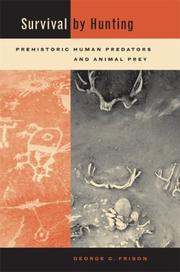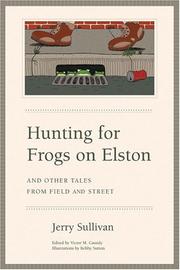| Listing 1 - 4 of 4 |
Sort by
|
Dissertation
Abstract | Keywords | Export | Availability | Bookmark
 Loading...
Loading...Choose an application
- Reference Manager
- EndNote
- RefWorks (Direct export to RefWorks)
Roe deer --- population density --- animal morphology --- Animal health --- Animal developmental stages --- animal ecology --- Gestion cynegetique --- Wallonie --- Gestion cynegetique --- Wallonie

ISBN: 1282356224 9786612356223 0520927966 9780520927964 9780520231900 0520231902 9781282356221 6612356227 Year: 2004 Publisher: Berkeley University of California Press
Abstract | Keywords | Export | Availability | Bookmark
 Loading...
Loading...Choose an application
- Reference Manager
- EndNote
- RefWorks (Direct export to RefWorks)
The North American Great Plains and Rocky Mountains have yielded many artifacts and other clues about the prehistoric people who once lived there, but little is understood about the hunting practices that ensured their survival for thousands of years. Noted archaeologist George Frison brings a lifetime of experience as a hunter, rancher, and guide to bear on excavation data from the region relating to hunting, illuminating prehistoric hunting practices in entirely new ways. Sharing his intimate knowledge of animal habitats and behavior and his familiarity with hunting strategies and techniques, Frison argues that this kind of firsthand knowledge is crucial for understanding hunting in the past.
Hunting and gathering societies. --- Paleo-Indians --- Hunting, Prehistoric. --- Food gathering societies --- Gathering and hunting societies --- Hunter-gatherers --- Hunting, Primitive --- Ethnology --- Subsistence hunting --- Paleo-Americans --- Paleo-Amerinds --- Paleoamericans --- Paleoamerinds --- Paleoindians --- Stone age --- Indians --- Prehistoric peoples --- Hunting and foraging, Prehistoric --- Hunting and gathering, Prehistoric --- Prehistoric hunting --- Hunting. --- american west. --- animal populations. --- animals as food. --- animals. --- antelope. --- apex predator. --- big horn mountains. --- bison. --- buffalo. --- conservation. --- deer. --- elk. --- environment. --- environmentalism. --- extinct animals. --- food studies. --- frontier. --- human animal relationships. --- hunter gatherer. --- hunting. --- indigenous culture. --- indigenous peoples. --- mountain sheep. --- mule deer. --- natural world. --- nature. --- nonfiction. --- paleo indians. --- persistence predator. --- plains animals. --- predator. --- prehistoric. --- prey. --- pronghorn. --- ranching. --- rocky mountains. --- substance hunting.

ISBN: 1282538187 9786612538186 0226779947 9780226779942 9780226779935 0226779939 0226779939 9781282538184 661253818X Year: 2004 Publisher: Chicago University of Chicago Press
Abstract | Keywords | Export | Availability | Bookmark
 Loading...
Loading...Choose an application
- Reference Manager
- EndNote
- RefWorks (Direct export to RefWorks)
A selection of savvy observations on urban ecology from one of the Midwest's foremost authorities on the subject, Hunting for Frogs on Elston collects the best of naturalist Jerry Sullivan's weekly Field & Street columns, originally published in the Chicago Reader. Engaging, opinionated, inspiring, and occasionally irreverent, Hunting for Frogs on Elston pays tribute to Chicago's natural history while celebrating one of its greatest champions. Published in association with the Chicago Wilderness coalition, Hunting for Frogs on Elston comprehensively chronicles Chicagoland's unique urban ecology, from its indigenous prairie and oft-delayed seasons to its urban coyotes and passenger pigeons. In witty, informed prose, Sullivan evokes his adventures netting dog-faced butterflies, hunting rattlesnakes, and watching fireflies mate. Inspired by regional flora and fauna, Sullivan ventures throughout the metropolis and its environs in search of sludge worms, gyrfalcons, and wild onions. In reporting his findings to otherwise oblivious urbanites, Sullivan endeavors to make "alienated, atomized, postmodern people feel at home, connected to something beyond ourselves." In the sprawling Chicagoland region, where an urban ecosystem teeming with remarkable life evolves between skyscrapers and train tracks, no writer chronicled the delicate balance of nature and industry more vividly than Jerry Sullivan. An homage to the urban ecology Sullivan loved so dearly, Hunting for Frogs on Elston is his fitting legacy as well as a lasting gift to the urban naturalist in us all.
Natural history. --- Urban ecology (Sociology) --- Cities and towns --- Urban ecology --- Urban environment --- Social ecology --- Sociology, Urban --- History, Natural --- Natural science --- Physiophilosophy --- Biology --- Science --- Environmental aspects --- urban ecology, naturalist, nature, environment, environmentalism, land management, prairie, indigenous, weather, seasons, animals, coyote, passenger pigeons, dog-faced butterflies, rattlesnakes, fireflies, industry, wild onions, gyrfalcons, sludge worms, community, nonfiction, science, plants, grasslands, deer, poplar creek preserve, lichen.
Article
Abstract | Keywords | Export | Availability | Bookmark
 Loading...
Loading...Choose an application
- Reference Manager
- EndNote
- RefWorks (Direct export to RefWorks)
A variety of recent rodent studies have suggested the use of an enriched environment as a strategy to increase the welfare of captive animals. However, a number of standard procedures of environmental enrichment are applied without taking into account the etho-ecological, species-specific, needs of laboratory animals. The aim of the present study was to evaluate the age and sex differences in the utilisation of a physically-enriched environment, consisting of four differently-shaped plastic compartments: a central chamber, a circle, a running wheel and a tower. These compartments are characterised by features (e.g. size, lightness, presence of food, opportunity to perform physical activity) of eco-ethological relevance for the mouse, the most common laboratory species. Presence and activity in each cage compartment during 5 consecutive days were assessed in juvenile (35 days old) and adult (90 days old) CD-1 mice of both sexes. Mice explored all the compartments, spending most of the time in the central chamber and making an extensive use of the running wheel. Juveniles of both sexes and adult males showed a prominent occupation of the central chamber, where food and sawdust were located, and they widely used it to sleep, suggesting that food availability might be a relevant factor in driving their choice of the resting location. Conversely, adult females displayed a more complex utilisation profile and preferentially stayed in the tower while inactive, suggesting that safety needs, that the covered structure of this compartment probably cater for, may be more relevant for them than availability of food and water resource. These findings indicate that in laboratory mice the features of an enriched environment are differentially relevant according to age and sex and, thus, may exert a different impact on their psycho-physical welfare. (C) 2004 Elsevier B.V. All rights reserved
Activity. --- Adolescent mice. --- Adult. --- Age and etho-ecological needs. --- Age. --- Animal welfare. --- Animal. --- Animals. --- Behaviour. --- Boxes. --- Cage. --- Choice. --- Deer mice. --- Enriched environment. --- Enriched. --- Enrichment. --- Environment. --- Environmental enrichment. --- Female. --- Females. --- Food availability. --- Food. --- Gender. --- Increase. --- Laboratory animals. --- Laboratory mice. --- Laboratory-animals. --- Laboratory. --- Locomotor-activity. --- Male. --- Males. --- Mice. --- Microtus-pennsylvanicus. --- Mouse. --- Mus-musculus. --- Need. --- Needs. --- Nesting materials. --- Novelty seeking. --- Old. --- Periadolescent mice. --- Physical activity. --- Physical-activity. --- Physical. --- Relevance. --- Rodent. --- Running wheel. --- Sex difference. --- Sex differences. --- Sex-differences. --- Sex. --- Sexes. --- Size. --- Sleep. --- Spatial ability. --- Strategies. --- Strategy. --- Time. --- Welfare.
| Listing 1 - 4 of 4 |
Sort by
|

 Search
Search Feedback
Feedback About UniCat
About UniCat  Help
Help News
News